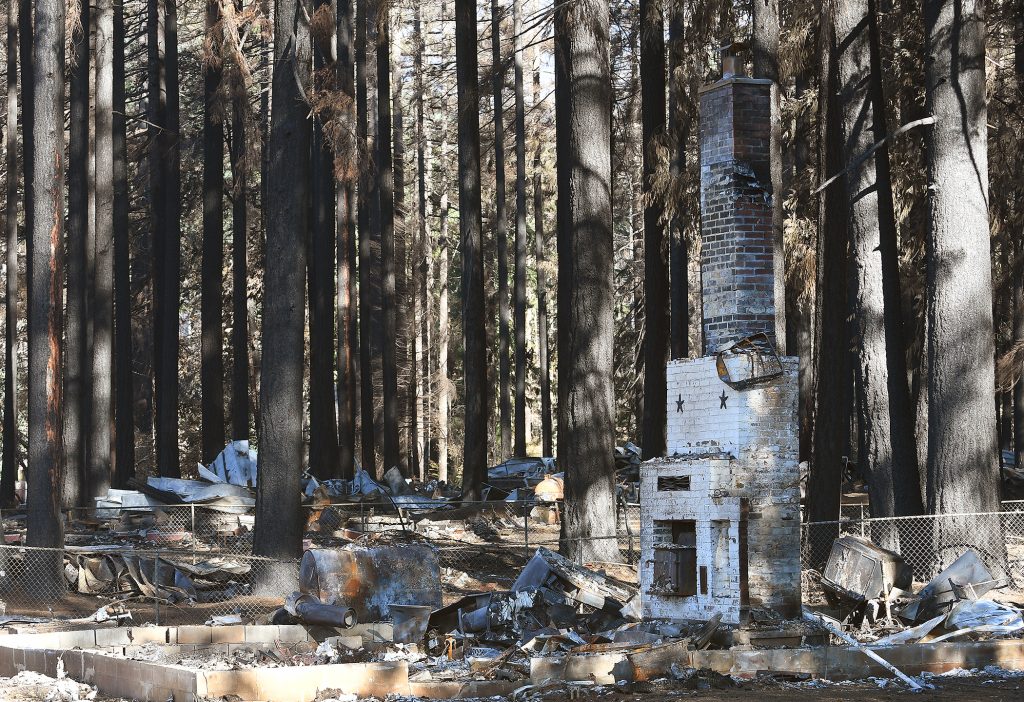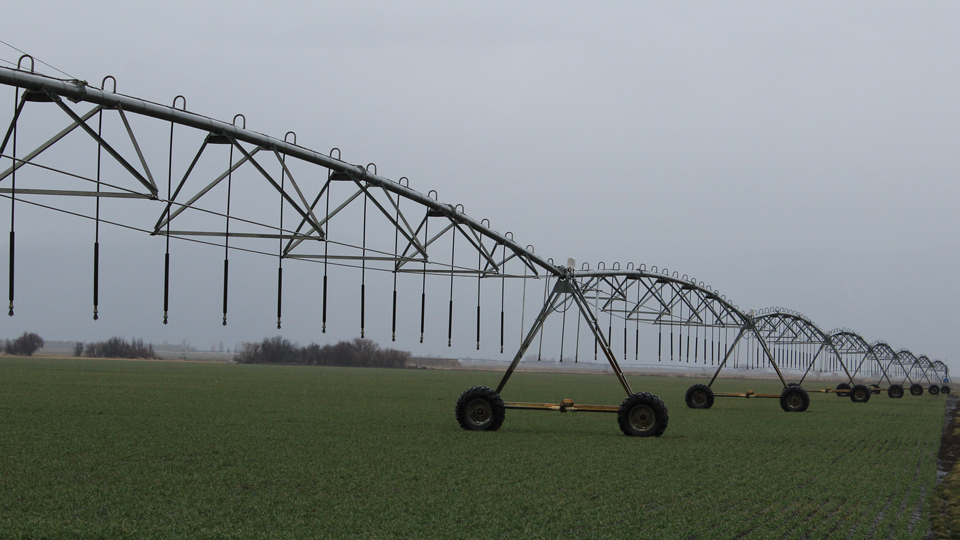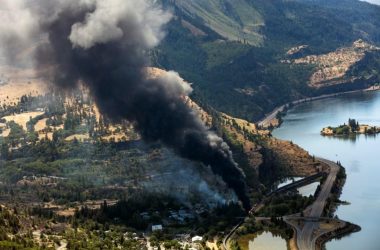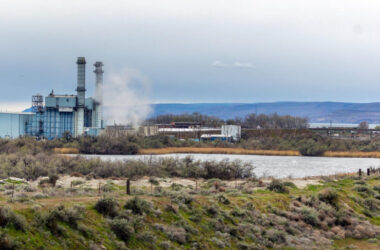Oregon’s gubernatorial race pits three candidates with two climate philosophies and asks one policy question to voters in November:
How green is green enough?
Wildfires loom, groundwater is disappearing and the tenor of Oregon’s response to the most destructive symptoms of human-caused climate change hinges on a tight contest for the governor’s chair.
Whoever wins will inherit a raft of aggressive climate rules and target reductions for emissions enacted by Gov. Kate Brown in 2020.

The issues
Fire: Since the start of the millennium, Oregon is seeing more, and more intense fires. The average acres burned has more than doubled in the last decade, from 318,775 acres from 2000-2010 to 648,607 acres between 2011 and 2021.
As fires get larger, they’re burning closer to or sometimes through towns. Lightning- and human-started fires swept across swaths of Oregon over Labor Day weekend in 2020: The Santiam Fire, east of Salem, razed more than 1,500 buildings, including 700 homes; the Almeda Fire near Medford destroyed 2,500 homes.
Fires that year killed 11, including two firefighters.
Water: The winner also will confront a historic drought, a 22-year- drying period that is the worst in 1,200 years. Some years are colder, but baseline temperature in the state rose 2.5 degrees Fahrenheit between 1900 and 2020.
Oregon’s water department and National Oceanic Atmospheric Administration research agree lakes and rivers are drying up, aquifers aren’t refilling and increasingly winter precipitation will fall as rain instead of snow.
As many as 259,500 Oregonians live in regions of the state experiencing extreme or worse drought conditions, mostly in vast counties in central and eastern Oregon.
Emissions: Whoever wins will inherit a raft of aggressive climate rules and target reductions for emissions enacted by Brown in 2020.
After Republicans walked out the statehouse in 2019 and 2020, including Republican candidate Christine Drazan that second year, Brown signed Executive Order 20-04, instituting a cap and trade program in Oregon. The goal is to drop statewide emissions to 80% below 1990 levels by 2050.
Executive orders are easier to dismantle than legislation signed into law, which means the next governor will oversee the launch of the Clean Energy Targets bill passed last year. It requires electricity providers to remove emissions-producing sources from the power they sell in Oregon by 2040. The state’s two largest electricity suppliers account for more than an estimated 17 million metric tons of CO2 each year.
Republican Drazan, nonaffiliated Betsy Johnson and Democrat Tina Kotek all agree that human-caused climate change is a problem. They diverge on how to treat the conflagrations and drought that now accompany warming temperatures.

Betsy Johnson, nonaffiliated
Given the chance, Johnson will try to steer a conversation about climate back to the same place she takes every topic — the middle.
When pressed about forest fires, however, the self-described “business-friendly Democrat” sounds more like her opponent on the Republican ticket. Johnson and Drazan both call for a faster U.S. Forest Service response to fires on its lands and more and better state wildfire-fighting resources.
“The problem statement is we’re burning the place up every year, and that is adding to environmental degradation,” Johnson said.
Johnson believes smoke from forest fires loads the atmosphere with greenhouse gasses that increase temperature in Oregon and therefore increase the state’s risk of major fires.
“We need to agree that part of the solution is thinning and prescribed burns,” she said.
Johnson would repeal Brown’s executive order regarding emissions. Instead, she would pursue innovation in “emission-reducing technology.” She’s not sure which technology — that’s someone else’s expertise, she said.
Johnson opposes requiring the state’s big investor-owned electric utilities to phase out sources of power that produce greenhouse gasses.
On the water side of the climate equation, Johnson pointed to her involvement in a stakeholder-mediated process to develop irrigation storage in Umatilla County.
Water problems will range across the state from contamination to there’s not enough, she learned, adding she now appreciates sitting down with local interests as key to the process.
“I’m an all-options-on-the-table, get-it-done governor,” Johnson said.
Johnson positioned herself in September between Democratic nominee Kotek and Republican Drazan while explaining to an Albany Chamber of Commerce crowd what she isn’t.
“Oregonians are skeptical of the far right and terrified of the progressive left,” she said.
Johnson said she wants to ensure she has bipartisan support rather than let one party “run roughshod” over the other.
She said Republican senators leaving Congress to block legislation is not the same thing as one party running roughshod over the other.
“When people feel shut out, not listened to, they get pissy,” Johnson said. “When you start out with the premise that you’re going to use the will of the majority, you’ve already lost the minority.”
Johnson’s voting received a score from Oregon League of Conservation Voters of 41% in line with the conservation lobby concern’s priorities.
Agriculture, energy production, finance and real estate were among the sectors with the largest financial contributions to Johnson’s campaign. Nike founder Phil Knight, whose political contributions sometimes serve as a clarion for Republican races in the state, gave $1.75 million to Johnson’s campaign.
Christine Drazan, Republican
(Editor’s note: Tina Kotek and Betsy Johnson readily agreed to be interviewed separately by the six reporters who contributed to this project. Christine Drazan, however, declined. This section is based on her statements and her record.)
The Republican nominee is staunchly against Brown’s climate legacy. Born in Klamath Falls, Drazan stumps on a platform of small-town origins and sympathy for people who make a living in the woods or farm fields.
She’s repeatedly said she’ll “tear up” Brown’s executive order calling for emission reductions “on Day One.”
Drazan has voted against most environmental-related proposals that came across her desk at the statehouse. Nays included a bill aiming to wean Oregon off of emissions-producing sources of electricity and incentives for energy efficient appliances and electric vehicles.
The Oregon League of Conservation Voters says Drazan was only 25% in line with initiatives the organization wanted to pass in the 2021 session.
But her platform is not devoid of environmental ideas. A plan emailed by Drazan’s campaign calls for investing in water storage, a technique for preserving water from high-flow times for dry periods.
It also emphasizes forest management as a balm against wildfire, and as a source of jobs.
Timber jobs began to decline under economic recession in the 1980s, according to the state Office of Economic Analysis. Federal land managers curtailed logging on U.S. lands, causing a gradual industry decline in the 1990s.
Jobs in wood products fell from historic highs of more than 80,000 to 70,000 in the ’80s, to 40,000 by the early 2000s. The sector lost another about 9,000 after the 2008 Great Recession, brought on by a housing bubble..
Wood products jobs generally have increased post-recession, from about 25,000 to 32,000 in Oregon.
More trees cut would net more jobs, concludes Josh Lehner, an economist for the state, but demand for timber will never be what it was during historic highs and automation means employment will never again relate to timber harvest the same way.
Drazan’s single largest financial backer by far is the Republican Governors Association, contributing $2.5 million to her campaign.
But a wood products company is the next largest with $500,000 contributed — Swanson Group Manufacturing LLC of Springfield. Eugene-based Murphy Plywood contributed $350,000.
And Timber Unity backed Drazen with a General Election endorsement. Johnson helped organize the group in 2019 that later drew attention when some of its leaders and staff entangled themselves with QAnon conspiracy theories and appeared at the Jan. 6 insurrection at the Capitol.
Drazan’s campaign website does not mention the endorsement.
Construction and agriculture also were among the top sectors financing the Drazan campaign.
Tina Kotek, Democrat
While her opponents say Brown’s executive order went too far, Kotek said she’s not changing it.
“The executive orders happened because the Republicans walked out on a comprehensive piece of legislation. I believe in the executive orders, I believe in moving the state forward,” she said.
States, including Oregon, have moved slowly to reach local and federal goals to cut millions of equivalent metric tons of CO2. Oregon missed a 2020 deadline.
That goal, set in 2007, aimed to reduce greenhouse gas emission to 10% less than the estimated 58 million metric tons of CO2 produced in the state in 1990. By 2016, Oregon was still 10% above the 1990 level.
Kotek said she’s open to suggestions and wants to hear from all of Oregon. But “what I don’t want to see is for us to stand still,” she said.
Kotek agrees with opponents who push thinning and prescriptive burning that mimics prehistoric fire regimens and keeps brush and debris from becoming potential fuel. But treating forests for fire is a half-measure, she said. Reducing the risk of fire starts in the state’s power consumption portfolio.
“We have to deal with emissions,” she said.
Kotek said she’s sensitive about reaching people in rural Oregon and wants to be a governor to everyone.
“If we’re not getting it right, if there are ways we can do better, then I’m open to suggestions,” Kotek said.
Kotek said she’ll lead with the best science she can find.
“I will not look kindly on people who are trying to politicize these issues,” she said.
She said she wants to harness a “diverse set of perspectives” at Oregon State University.
“I look forward to digging in with all those folks and saying, ‘OK — which ones are going to take us forward,” she said. “You know what Oregonians care about? Our forests, and we have to make good decisions together.
Kotek’s campaign took its largest contributions from trade and public employee unions, health care; and a mix of manufacturing, finance, real estate and energy production sector contributions.
The Democratic Governors Association had contributed $3.05 million by Sept. 29. Stand for Children Oregon had spent $580,000; Citizen Action for Political Education, $465,000; OEA-PAC, AFSCME International and Oregon League of Conservation Voters all contributed $250,000.
Oregon League of Conservation Voters endorsed Kotek, who fell in line with its priorities 95% of the time in 2021.

How they voted – on the environment
- Votes on the environment
- HB 2020 (2019 regular session) passed the House but died in the Senate.
- Would have capped some of Oregon’s greenhouse gas emissions.
- HB 2020 (2019 regular session) passed the House but died in the Senate.
- Drazan — No
- Johnson — (did not make it to a Senate vote)
- Kotek — Yes
- SB 1530 (2020 regular session) Drazan led a walkout protesting the bill, which was dropped after a vote in the Joint Ways and Means Committee.
- Would have capped some of Oregon’s greenhouse gas emissions.
- Drazan — No
- Johnson — No
- Kotek — (not on committee)
- Would have capped some of Oregon’s greenhouse gas emissions.
- HB 3375 (2021 regular session) passed
- Required the Oregon Department of Energy to create a report about the benefits and challenges of developing up to 3 gigawatts of floating offshore wind energy projects within federal waters off Oregon’s Coast by 2030.
- Drazan — Yes
- Johnson — No
- Kotek — Yes
- Required the Oregon Department of Energy to create a report about the benefits and challenges of developing up to 3 gigawatts of floating offshore wind energy projects within federal waters off Oregon’s Coast by 2030.
- SB 762 (2021 regular session) passed
- Provided more than $220 million for wildfire preparedness by creating fire-adapted communities, a process that includes controlled burns, statewide fire risk mapping and programs to improve forest resilience.
- Drazan — Yes
- Johnson — Yes
- Kotek — Yes
- Provided more than $220 million for wildfire preparedness by creating fire-adapted communities, a process that includes controlled burns, statewide fire risk mapping and programs to improve forest resilience.
- HB 2007 (2019 regular session) passed
- Directed funds to phase out diesel emissions in Oregon some older-model diesel engines registered in Multnomah, Clackamas and Washington County.
- Drazan — No
- Johnson — No
- Kotek — Yes
- Directed funds to phase out diesel emissions in Oregon some older-model diesel engines registered in Multnomah, Clackamas and Washington County.
– Alexis Weisend from the Catalyst Journalism Project at the University of Oregon
Alex Powers is a reporter for the Albany Democrat-Herald.
THE SERIES:
VOTE 2022: Candidates for Oregon governor differ on abortion
VOTE 2022: Governor candidates have divergent views on mental health care
VOTE 2022: Candidates for governor face economic challenges ahead
VOTE 2022: Next governor faces significant challenge in housing crisis
VOTE 2022: Governor candidates talk about reforms, relief for schools
This story is part of a newsroom collaboration for the governor’s race, with six newsrooms each tackling where Republican Christine Drazan, nonaffiliated candidate Betsy Johnson and Democrat Tina Kotek, stand on a key topic. TheAlbany Herald-Democrat wrote about wildfires and drought;Ashland News covered health care, including mental health; theMail Tribune wrote about abortion, theOregon Capital Chronicle covered housing, theSalem Reporter covered education andYachats News wrote about the economy and cost of living.




